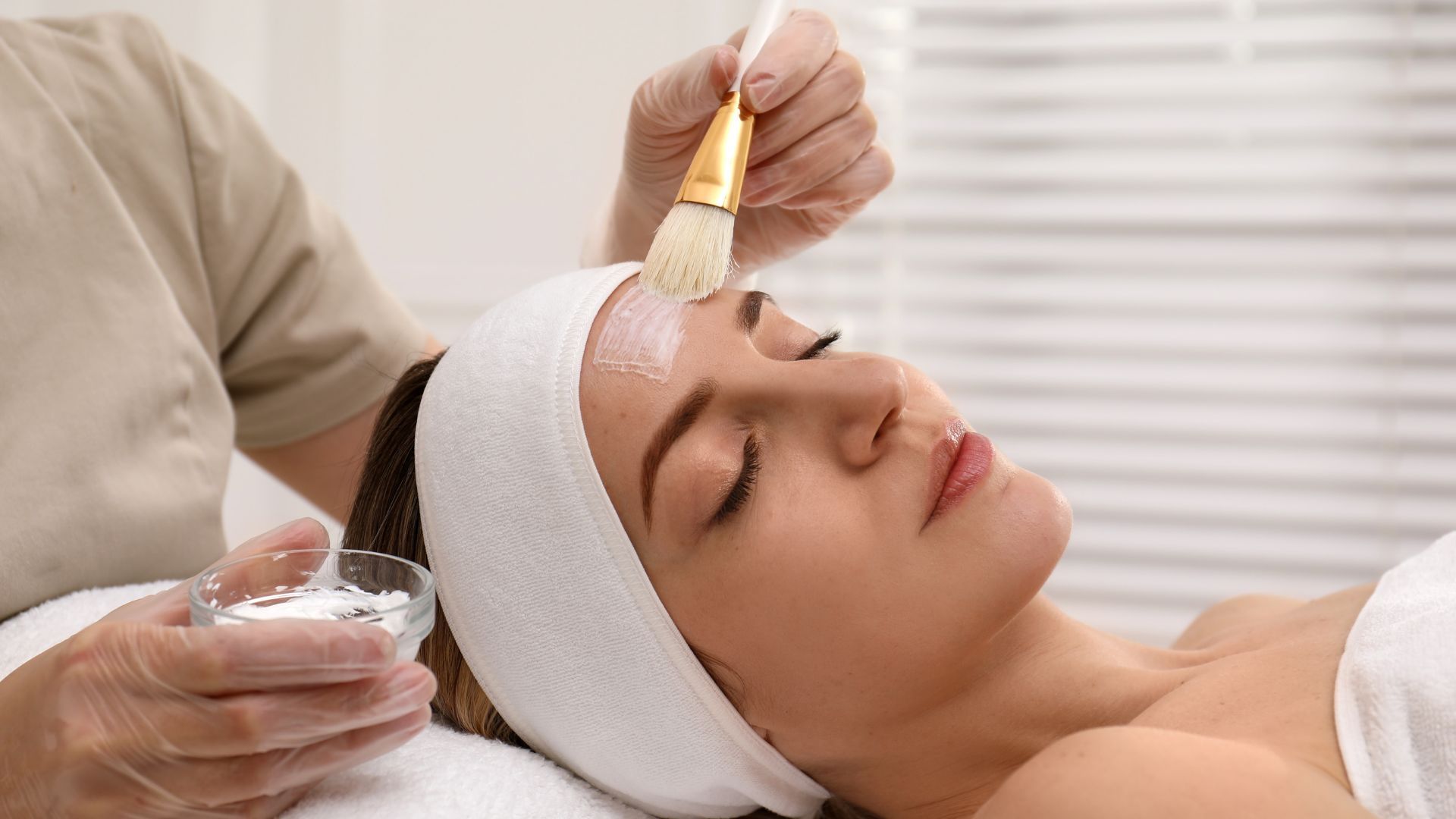Why Skin Peel Facials Are the Go-To Treatment for Clearer Skin
Skin peel facials have become a popular treatment for clearer, rejuvenated skin. This dermatological procedure uses a chemical solution to exfoliate and remove outer skin layers, revealing a smoother complexion. They effectively address various skin concerns, including acne, hyperpigmentation, fine lines, and uneven texture.
By promoting cell turnover and boosting collagen production, these facials lead to healthier, more radiant skin. With options ranging from mild to intense peels, treatments can be customized for individual skin types and concerns, making skin peel facials a reliable choice in skincare.
The Mechanism Behind Chemical Peels

Chemical peels, also known as chemical peeling, leverage specific acids to aid in skin exfoliation and rejuvenation. Through the application of a chemical solution, the procedure removes damaged outer layers of the skin, effectively improving skin texture and appearance. This process is beneficial for tackling concerns such as rough skin, acne scars, and uneven skin tone.
Types of Chemical Peels
Chemical peels are categorized based on their depth and intensity:
- Superficial Peels: Often referred to as light chemical peels, they use milder acids like glycolic acid or lactic acid. These are ideal for minimal exfoliation, targeting minor imperfections, and promoting a radiant skin glow.
- Medium Chemical Peels: Utilizing agents like trichloroacetic acid, these peels penetrate deeper, addressing moderate skin issues such as uneven skin tone and fine lines.
- Deep Peels: These intense treatments, also known as deep chemical peels, focus on more pronounced skin issues. They provide significant results by deeply penetrating and rejuvenating the skin layers.
Key Ingredients in Chemical Peels
- Glycolic Acid: Common in superficial peels, it gently exfoliates, enhancing overall skin texture and glow.
- Salicylic Acid: Used in salicylic acid chemical peels, this ingredient is effective in treating acne and reducing pore clogging by penetrating oily skin layers.
- Lactic Acid: Another popular choice for superficial peels, lactic acid helps to moisturize and exfoliate the skin simultaneously.
- Trichloroacetic Acid (TCA): Employed in medium to deep peels, TCA effectively targets more stubborn skin concerns like deep wrinkles and scars.
The Healing Process
Following a chemical peel, the skin heals over time as the treated layers peel away to reveal healthier skin underneath. As part of cosmetic surgical procedures, it is crucial to follow post-treatment care guidelines to ensure optimal healing and lasting results. The regeneration of new skin cells results in improved skin appearance, with smoother, more even-toned, and radiant skin as the outcome.
The Role of Chemical Peels in Reducing Acne and Breakouts

Chemical peels are a powerful tool in the fight against acne and its lingering effects, such as acne scarring. By leveraging varying strengths of chemical agents, these treatments can effectively cleanse and exfoliate the skin, promoting a clearer complexion and more youthful skin.
Impact on Acne
Chemical peels, particularly light and medium chemical peels, help reduce active acne by unclogging pores and removing excess oil and dead skin cells. The application of chemicals like salicylic acid and glycolic acid penetrates the skin's surface to dissolve impurities, diminishing the prevalence of acne breakouts and leading to healthier skin.
Reduction of Acne Scarring
The process becomes more intensive with medium and deep chemical peels, which target deeper layers of the skin to combat more stubborn acne scarring. By stimulating new cell growth and collagen production, these peels significantly enhance the skin's texture and appearance, resulting in more youthful skin devoid of the remnants of past acne.
Importance of Professional Guidance
Undergoing a chemical peel should ideally be overseen by a dermatologic surgeon or a licensed dermatologist to ensure safety and effectiveness. A professional's expertise helps determine the appropriate peel type and intensity needed for individual skin conditions, effectively balancing the peel's benefits against potential side effects from sun exposure or other environmental factors.
Post-Peel Care and Sun Sensitivity
After experiencing a chemical peel, especially after a medium peel or deep peel, it is vital to protect the skin from direct sun exposure. The renewed skin is particularly sensitive, and proper care, including the use of sunscreens and protective clothing, helps preserve the peel's results and prevent potential damage from sun exposure. With diligent post-treatment care, the improvements achieved from chemical peels pave the way for clearer, more radiant, and youthful skin.
How Glycolic Acid in Skin Peels Helps Brighten and Smooth Skin

The Benefits of Glycolic Acid in Chemical Peels
Glycolic acid, a key player in chemical peels, predominantly features light chemical peels but can be formulated for medium-depth peels. This alpha hydroxy acid (AHA) originates from sugar cane and works as a chemical solution to effectively exfoliate the outermost layer of the skin. By penetrating the skin's surface, glycolic acid exfoliates dead skin cells, reduces brownish discoloration, and addresses dark patches associated with sun damage and post-inflammatory hyperpigmentation, often seen in darker skin.
Mechanism of Action
The application of glycolic acid in skin peels results in a controlled injury to the skin, which then accelerates the natural turnover process. This exfoliation leads to smoother, brighter treated skin. While it offers a temporary change in skin appearance, repeated treatments can culminate in more permanent skin improvements such as diminished moderate lines and refined texture.
Addressing Skin Concerns
Glycolic acid peels are particularly effective in alleviating superficial skin concerns with minimal downtime. They can also be included in medium peels for deeper rejuvenation, targeting deep scars, moderate lines, and signs of aging. Patients might experience a stinging sensation during the procedure, but the discomfort is typically fleeting.
Post-Peel Care and Precautions
Post-treatment care for glycolic acid chemical peels involves avoiding sun exposure for five to seven days, as the treated skin is particularly vulnerable to UV damage. Consistent sun protection is crucial to maintain results and prevent new dark patches. For those using birth control pills or antiviral medication, consulting a dermatologic professional is advised to avert unpredictable skin reactions.
Preparation and Usage
Patients are often advised to discontinue certain medications, such as oral antibiotics, before their chemical peel procedure. Furthermore, wearing makeup might be restricted immediately after treatment to ensure optimal healing and prevent irritation. The experience and results can vary, especially for individuals with darker skin, hence professional guidance is recommended before using glycolic acid peels to prevent post-inflammatory hyperpigmentation.
Benefits of Chemical Peels for Reducing Hyperpigmentation and Dark Spots

Understanding Hyperpigmentation and Dark Spots
Hyperpigmentation and dark spots are common skin conditions characterized by patches of skin becoming darker than the surrounding areas. This can result from increased melanin production due to various factors, including sun exposure, hormonal changes, inflammation, or a family history of skin discolorations. Chemical peels serve as an effective outpatient procedure to address these issues, offering significant improvement over time.
The Benefits of Light Peels
Light peels, often administered in a surgery center or dermatologist's office, gently exfoliate the outermost layer of the skin. These peels are an ideal first line of treatment for hyperpigmentation and dark spots, gradually lightening the affected areas by promoting cell turnover. Light peels are particularly beneficial for those with a family history of hyperpigmentation, as they tend to have minimal recovery time and allow patients to return to their daily routines swiftly.
Targeting Treatment Areas with Medium and Deep Peels
Medium and deep peels offer more intensive treatment for stubborn dark spots and hyperpigmentation. By penetrating deeper into the skin layers, these peels can achieve more dramatic results, eventually peeling away the discolored layers to reveal more uniform skin underneath. Patients may undergo medium or deep peeling at a surgery center to ensure a controlled environment and the necessary expertise.
The Role of Prescribed Medication
In conjunction with chemical peels, dermatologists may prescribe medication to enhance the treatment's effectiveness. Topical treatments, including retinoids or bleaching agents like hydroquinone, can complement the peeling process by further lightening the skin before and after the procedure. It's essential to follow professional recommendations to minimize risks and ensure optimal outcomes.
Post-Treatment Care and Precautions
After undergoing a chemical peel, especially a medium or deep peel, patients must adhere strictly to post-treatment care instructions. This includes avoiding sun exposure, using high-SPF sunscreens, and following a dermatologist's prescribed skincare regimen. Proper care helps maintain the benefits of the peel and prevents future hyperpigmentation or dark spots, promoting a clearer and more even complexion.
Why Skin Peel Facials Are Effective for Addressing Fine Lines and Wrinkles

Understanding the Role of Chemical Peels
Skin peel facials, encompassing deep chemical peels, light chemical peels, and medium chemical peels, have gained popularity as effective cosmetic procedures for addressing fine lines and wrinkles. These peels utilize chemical solutions to exfoliate and rejuvenate the skin, offering both temporary and, in some cases, more permanent changes in appearance.
Mechanism of Action
Chemical peels work by removing layers of damaged skin, stimulating new cell growth and collagen production, which results in a smoother and more youthful complexion. Deep chemical peels penetrate the skin more thoroughly to address more prominent wrinkles, while light chemical peels provide gentle exfoliation, more suitable for younger skin or as a part of regular maintenance.
Benefits of Different Peel Depths
- Light Chemical Peel: Ideal for those starting to notice early signs of aging, a light peel can address slight fine lines and surface irregularities with minimal downtime.
- Medium Chemical Peel: Targets treatment areas with moderate wrinkles and age spots, offering significant improvement for visible signs of aging.
- Deep Chemical Peel: Suitable for deeper wrinkles, this level of peel achieves dramatic results, typically requiring longer recovery but promising more substantial changes.
Considerations for Different Skin Types
Selecting the appropriate peel depth is crucial, and factors such as skin type, medical history, and desired outcomes should be considered. Consulting with a professional is essential to prevent complications, especially when dealing with potent agents like carbolic acid in deep peels.
Post-Treatment Expectations and Care
After undergoing a chemical peel, it is vital to adhere to post-treatment care instructions. Patients are often advised against wearing makeup immediately after a procedure to allow for optimal healing. Moreover, strict sun protection is necessary to preserve results and prevent complications such as hyperpigmentation.
The strategic application of skin peel facials allows for the treatment of fine lines and wrinkles efficiently. With careful selection of the appropriate type of peel and diligent aftercare, patients can enjoy smoother, rejuvenated skin, benefiting from both temporary enhancements and longer-term aesthetic improvements.
The Science Behind Cell Turnover and Its Impact on Clearer Skin

Understanding Cell Turnover
Cell turnover is the process by which the skin naturally renews itself, shedding old cells and generating new ones. This continuous cycle is crucial for maintaining healthy, vibrant skin. As we age, the rate of cell turnover slows down, leading to the accumulation of dead skin cells on the surface. This can result in dullness, clogged pores, and the appearance of age spots, prompting many to explore cosmetic procedures to enhance skin clarity.
Impact on Skin Clarity
Improved cell turnover has a profound effect on the treatment area by promoting a clearer, more even complexion. When the outermost layer of dead cells is removed, either naturally or through methods like chemical peels, it allows for the underlying fresh skin cells to emerge. Over time, this process can either bring about temporary or permanent changes in the skin’s appearance, contributing to a reduction in age spots and uneven texture.
The Role of Chemical Peels
Chemical peels are a popular cosmetic procedure that accelerates cell turnover by employing chemical agents to exfoliate the skin. Depending on the peel's depth, they can either gently or intensely impact the treatment area. Peels allow skin layers to eventually peel away, unveiling healthier, rejuvenated cells beneath. This not only enhances skin clarity but also aids in smoothing out fine lines and addressing age-related concerns.
Benefits of Enhanced Cell Turnover
Facilitating cell turnover through chemical peels can yield significant aesthetic benefits, promoting smoother, more youthful skin. By regularly participating in these treatments, individuals can better manage age spots and skin irregularities, contributing to an overall healthier appearance. As cell turnover is essential in maintaining skin vitality, it is also a vital consideration when determining the potential of cosmetic procedures for rejuvenating the complexion.
Understanding and managing cell turnover effectively allows individuals to achieve clearer skin and more consistent results from cosmetic treatments, aligning with both temporary and long-term skincare goals.
Customizing Chemical Peels to Address Individual Skin Types and Concerns
Tailoring Chemical Peeling for Optimal Results
Chemical peeling can be tailored to address various individual skin types and concerns, ensuring both temporary or permanent changes are achieved for a healthier appearance. With attention to specific skin needs, clients can maximize the benefits of procedures ranging from light chemical peels to deep chemical peels. Each treatment plan should be customized to target issues such as rough skin, uneven complexion, or persistent age spots.
Selecting the Right Chemical Solution
Choosing the appropriate chemical solution is crucial for successful outcomes. Lighter peels often use milder acids like glycolic or lactic acid to gently exfoliate and rejuvenate without extensive recovery time. Medium chemical peels typically involve trichloroacetic acid (TCA) for addressing moderate skin concerns, including rough skin textures and pronounced pigmentation. A deep peel, utilizing agents such as carbolic acid, targets severe signs of aging, offering more substantial improvements at the cost of longer recovery periods.
Considerations for Skin Types and Recovery
Each skin type reacts differently to various peel strengths, necessitating expert consultation when planning a treatment. For oily skin, a light chemical peel may help manage excess oil and improve texture, while a medium chemical peel might be better suited for combination skin types struggling with uneven pigmentation. Deep chemical peels can yield dramatic outcomes for individuals with fair skin prone to significant scarring or deep-set wrinkles, requiring careful post-procedure care.
Integrating Procedures Into Skincare Routines
Chemical peels can seamlessly integrate into skincare routines, enhancing daily regimens designed to promote clearer, more youthful skin. Clients should follow post-treatment guidelines to maintain results, including avoiding exposure to sunlight and delaying the decision to wear makeup until healing is complete. Regular peels can complement products that support cell turnover and hydration, ensuring long-lasting results and a consistent, fresh appearance.
Customizing chemical peels to fit individual needs not only enhances the overall efficacy of the treatment but also supports both temporary rejuvenation and permanent improvements in skin health. Through targeted solutions and personalized care, chemical peeling continues to be an invaluable tool for anyone seeking transformative results.
How Deep Peels Target Severe Skin Issues for Long-Lasting Results
Understanding Deep Chemical Peels
Deep chemical peels are potent cosmetic surgical procedures designed to address severe skin issues, offering long-lasting results and a transformative effect on the skin. Unlike light chemical peels or medium chemical peels, deep peels penetrate several layers of the skin to target deep-set wrinkles, acne scars, and pronounced pigmentation problems. By utilizing agents such as carbolic acid, these treatments are capable of significantly altering the skin's texture, tone, and appearance.
The Role of a Dermatologic Surgeon
A dermatologic surgeon plays a crucial role in administering deep chemical peels, ensuring the procedure is tailored to the individual's specific skin concerns. They assess the patient's skin type, the severity of skin issues, and overall health to determine suitability and customize the treatment plan accordingly. Expertise in cosmetic surgical procedures is essential to safely handle the intensity of deep peels, manage the skin's healing process, and optimize outcomes.
The Healing Process and Emergence of New Skin
Following a deep chemical peel , the skin undergoes a meticulous healing process, during which the treated outer layers peel away over time. This peeling reveals new skin, which is usually smoother, more even-toned, and rejuvenated. Patients may experience some downtime as the skin heals, but the longevity of the results often makes the recovery period worthwhile. Proper aftercare and adherence to guidelines provided by the dermatologic surgeon are essential for maximizing the benefits of the treatment.
Long-Lasting Results and Maintenance
The dramatic changes achieved through deep chemical peels often offer long-lasting results, especially for those struggling with persistent acne scars or significant signs of aging. Patients may not require frequent re-treatment, although maintaining a healthy skincare routine and protecting the skin from sun damage is crucial for prolonging outcomes. When integrated with daily skincare practices optimized for cell turnover and hydration, deep chemical peels can contribute significantly to sustained skin health and aesthetics.
Deep chemical peels stand out in the realm of cosmetic surgical procedures for their ability to target severe skin issues comprehensively. By undergoing this intensive treatment under the guidance of a skilled dermatologic surgeon, individuals can achieve profound improvements that enhance both their appearance and well-being.
Ready to Transform Your Skin?
At Bel Viso Medical Spa, we are dedicated to helping you achieve radiant, healthier skin through personalized chemical peel treatments. Our team of expert dermatologists and aestheticians will guide you every step of the way, ensuring a treatment plan tailored to your specific needs.
Whether you're considering a light peel for a subtle refresh or a deep peel for dramatic changes, we have the expertise and state-of-the-art technology to deliver exceptional results.
Don't wait any longer to experience the benefits of a glowing, youthful complexion. Contact Bel Viso Medical Spa today to schedule your consultation and embark on a transformative journey towards beautiful skin.
Our Recent News & Articles


We are here to enhance your natural beauty. When you walk into our medical spa, the focus is on you. We promote a collaborative treatment plan between the provider and client to achieve a realistic aesthetic outcome.
All Rights Reserved | Bel Viso Medical Spa
WEB SERVICES BY: LEVELUP DIGITAL SOLUTIONS



